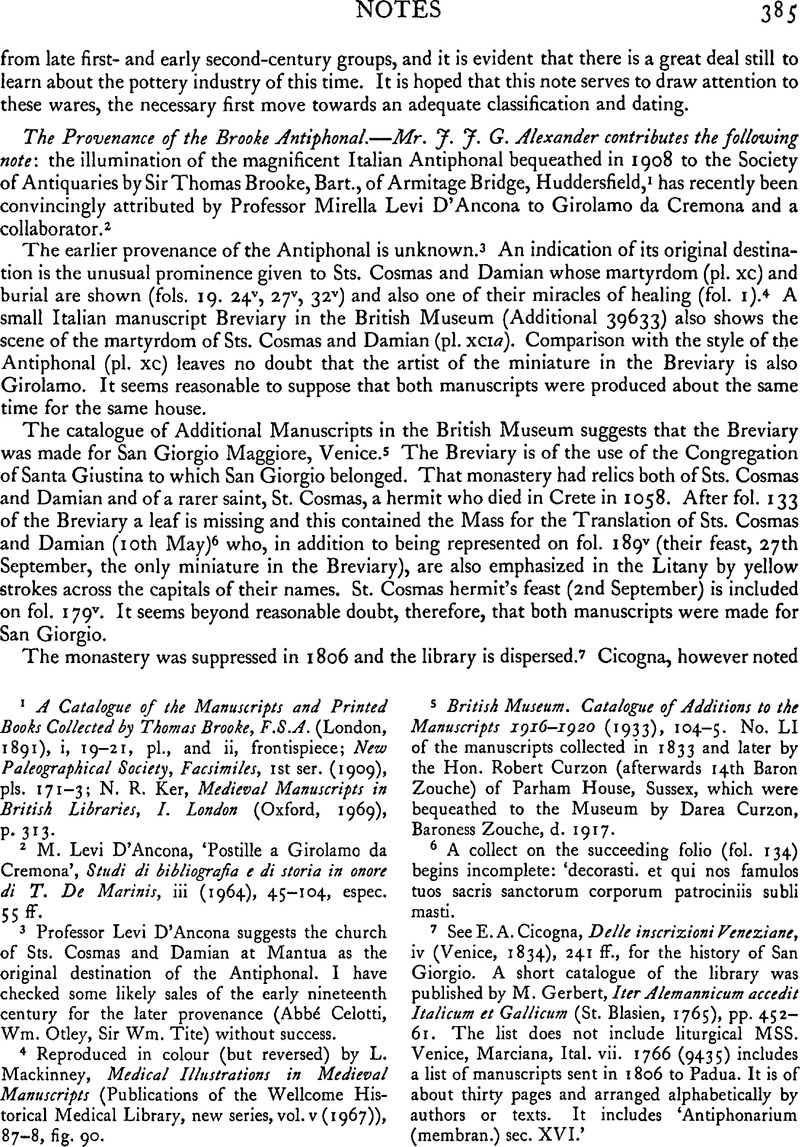No CrossRef data available.
Article contents
The Provenance of the Brooke Antiphonal
Published online by Cambridge University Press: 29 November 2011
Abstract

- Type
- Notes
- Information
- Copyright
- Copyright © The Society of Antiquaries of London 1969
References
page 385 note 1 A Catalogue of the Manuscripts and Printed Books Collected by Thomas Brooke, F.S.A. (London, 1891), i, 19–21, pl., and ii, frontispieceGoogle Scholar; New Paleographical Society, Facsimiles, 1st ser. (1909), pls. 171–3Google Scholar; Ker, N. R., Medieval Manuscripts in British Libraries, I. London (Oxford, 1969), p. 313Google Scholar.
page 385 note 2 D'Ancona, M. Levi, ‘Postille a Girolamo da Cremona’, Studi di bibliografia e di storia in onore di T. De Marinis, iii (1964), 45–104, espec. 55 ffGoogle Scholar.
page 385 note 3 Professor Levi D'Ancona suggests the church of Sts. Cosmas and Damian at Mantua as the original destination of the Antiphonal. I have checked some likely sales of the early nineteenth century for the later provenance (Abbé Celotti, Wm. Otley, Sir Wm. Tite) without success.
page 385 note 4 Reproduced in colour (but reversed) by Mackinney, L., Medical Illustrations in Medieval Manuscripts (Publications of the Wellcome Historical Medical Library, new series, vol. v (1967)), 87–8, fig. 90Google Scholar.
page 385 note 5 British Museum. Catalogue of Additions to the Manuscripts 1916–1920 (1933), 104–5.Google Scholar No. LI of the manuscripts collected in 1833 and later by the Hon. Robert Curzon (afterwards 14th Baron Zouche) of Parham House, Sussex, which were bequeathed to the Museum by Darea Curzon, Baroness Zouche, d. 1917.
page 385 note 6 A collect on the succeeding folio (fol. 134) begins incomplete: ‘decorasti. et qui nos famulos tuos sacris sanctorum corporum patrociniis subli masti.
page 385 note 7 See Cicogna, E. A., Delle inscrizioni Veneziane, iv (Venice, 1834), 241 ff.Google Scholar, for the history of San Giorgio. A short catalogue of the library was published by Gerbert, M., Iter Alemannicum accedit Italicum et Gallicum (St. Blasien, 1765), pp. 452–61.Google Scholar The list does not include liturgical MSS. Venice, Marciana, Ital. vii. 1766 (9435) includes a list of manuscripts sent in 1806 to Padua. It is of about thirty pages and arranged alphabetically by authors or texts. It includes ‘Antiphonarium (membran.) sec. XVI.’
page 386 note 1 Op. cit., p. 376, n. 302.
page 386 note 2 Op. cit., p. 318, n. 171a.
page 386 note 3 I am grateful to S. Luigi Lanfranchi of the Archivio di Stato, Venice, for his help over the San Giorgio archives and also to Dr. Rachel Meoli, Padua, who looked at the archives for me before I was myself able to visit them.
page 386 note 3 Mantegna painted the altar-piece of Sta. Giustina, Padua (to whose congregation San Gior-gio belonged) in 1453–4. On fol. 15v of the Antiphonal is an initial added in the sixteenth century. It bears the inscription: ‘Magister Andreas et Franciscus de Mantinea ornarunt cartas artibus egregiis. Frater Jacobus de Mantua P.P.M.’ Who Jacobus de Mantua was, is not known, though he has been conjectured to be a miniaturist born in 1515 (New Pal. Soc, op. cit.). Mantegna usually signed himself Andreas Mantegna or Mantinia, less frequently Mantinea. Could the ascription of the miniatures to Mantegna and his son have rested on a tradition at San Giorgio? Conceivably Mantegna was acting as an entrepreneur as he seems to have done for the Mantua Missal. Or was there a general tradition that Mantegna had sometimes worked as an illuminator? (Cf. Vasari's, statement that in the chapel of Innocent VIII in the Vatican ‘la volta ele mura paiono piuttosto cosa miniata che dipin-tura’, ed. Milanesi, G., iii (1878), 400Google Scholar, and Meiss, M., Andrea Mantegna as Illuminator (Hamburg, 1957).)Google Scholar Curiously enough Cicogna notes, p. 489, that Pope Pius VII after his election at San Giorgio in 1800 received gifts from the monasteries and the chapter of the Cathedral at Padua, amongst which was an Antiphonal ‘in carta pergamena con minia-tura del celebre Mantegna molto celebrato dagl’ intendenti di bibliografia e miniature’. Could there be some muddle in Cicogna's sources here?
page 386 note 5 D'Ancona, Levi, op. cit., p. 55, n. 1.Google Scholar Franco was in Venice c. 1463–5 when he illuminated the oratio gratulatoria of Bembo to Doge Moro, Brit. Mus., Add. 14787. See D'Ancona, M. Levi, ‘Contributi al problema di Franco dei Russi’, Commentari, xi (1960), 33–45.Google Scholar There is a second artist in the Breviary too, fols. 1 and 81. He seems to be a Ferrarese artist working in the style of Martino da Modena. Brit. Mus., Stowe MS. 29, Hours, arms of Erizzo and Priuli of Venice, also has Ferrarese school illumination. Fol. 178 is very close to Martino himself. The miniatures inserted at the end of the Breviary which are from another manuscript are of mediocre quality, possibly Neapolitan, late fifteenth century.
page 386 note 6 MS. Typ. 465. Calendar and litany suggest Padua as provenance (S. Daniele, Sta. Giustina, S. Prosdocimus). Other historiated initials are on fols. 144, 150v, 162.
page 386 note 7 For Leonardo see Moretti, L., ‘Di Leonardo Bellini, pittore e miniatore’, Paragone, ix (1958), 58–66Google Scholar.
page 387 note 1 As, for example, in the miniature added to a Gratian, Decretum, printed in Venice by Nicholas Jenson, 28 June 1474 (Brit. Mus., IC 19678). This is an early work, I would suggest, of the artist, possibly Jacometto Veneziano (cf. O. Pächt, Italian Illuminated Manuscripts, catalogue of an exhibition in the Bodleian Library, 1948, no. 69, pl. xvn), who later illuminated the two-volume Aristotle in the Morgan Library, New York, E. 41A, E. 2. 78B. Professor Levi D'Ancona, on the other hand, attributes the Aristotle to Girolamo himself (op. cit., pp. 68, 71ff., pl. XIII) Girolamo received a payment in Siena in April 1474. Another manuscript closely related to this group is Paris, Bibliotheque Mazarine, MS. 366, a Venetian Breviary. Leroquais, V., Les Briviaires mamtscrits dans les bibliotheques publiques de France, ii (Paris, 1934). 404 pl. LXXXVIIGoogle Scholar.




